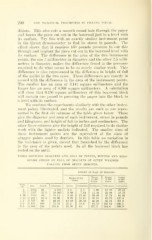Page 510 - My FlipBook
P. 510
240 THE TECHNIC.VX, PEOCEDURES IN FILLING TEETH.
ditions. This also cuts a smooth round hole through the paper
and buries the piece cut out in the boxwood just to a level with
its surface. Tiy this with an exactly similar instrument point
in the thrust djTiamometer to find its stress in pounds. The
etfort shows that it requires 160 pounds pressure to cut this
through and implant the piece cut out in the boxwood level with
its surface. The difference in the area of the two instrument
points, the one 2 millimeters in diameter and the other 2.5 milli-
meters in diameter, makes the difference found in the pressure
required to do what seems to l)e so nearly similar work. This
difference is also represented in the difference in height of fall
of the mallet in the two cases. These differences are exactly in
accord with the difference in the area of the instrument points.
The smaller has an area of 3.141 square millimeters and the
larger has an area of 4.908 square millimeters. A calculation
will show that 0.196 square millimeters of this boxwood block
will sustain one pound in pressing the paper into the block to
a level with its surface.
We continue the experiments similarly with the other instru-
ment points illustrated, and the results are such as are repre-
sented in the first six columns of the table given below. These
give the diameter and area of each instrument, stress in pounds
and kilograms, and height of fall in inches and centimeters. The
other three columns give the height of fall required to do similar
work with the lighter mallets indicated. The smaller sizes of
these instrument points are the equivalent of the sizes of
phigger points used by dentists. In this table no variation in
the resistance is given, except that furnished by the difference
in the area of the points used. In all the boxwood block has
rested on the anvil.
TABLE SHOWING DIAMETER AND AREA OF POINTS, POUNDS AND KILO-
GRAMS STRESS BY FALL OF MALLETS OF GIVEN WEIGHTS
FALLING FROM GIVEN HEIGHTS.


